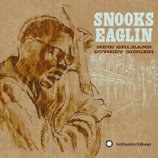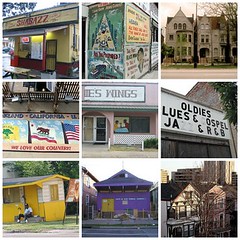The Snooks version & the ballad context
 Extremely dedicated readers of this site may recall a December 2005 post wherein I did my best to answer a question from reader Klaas T. of Amsterdam. He was looking for an old Snooks Eaglin version, and I was able to point him to the 1959 Folkways record, Snooks Eaglin: New Orleans Street Singer. At the time, all I'd heard of that version was the sample available on the Folkways site.
Extremely dedicated readers of this site may recall a December 2005 post wherein I did my best to answer a question from reader Klaas T. of Amsterdam. He was looking for an old Snooks Eaglin version, and I was able to point him to the 1959 Folkways record, Snooks Eaglin: New Orleans Street Singer. At the time, all I'd heard of that version was the sample available on the Folkways site.Turns out that this same recording appears on a new CD called Classic African-American Ballads, which I recently bought and which deserves a moment of consideration. As scholar Barry Lee Pearson explains in the CD booklet, the point of the compilation is "to reacquaint the listener with a relatively neglected body of African-American folksong." He draws a distinction between these "story songs" and the blues, and defines the ballad in this context as "a song that tells a story, comes in short verses (with or without a refrain), and is song to a short, repeated melody."
Most of the selections are African-American compositions; "St. James Infirmary" is one of four that are "adopted from British traditions." (The others are "The Gallis Pole," "Mouse on the Hill," and "Stewball.") Pearson writes that the heyday of the African-American ballad was the period from 1885 to 1925, an era of black migration from the rural South to cities from St. Louis to New York. One of his most interesting observations is this:
Many black ballads, as products of these urban environments, provide glimpses of African-American city life at the turn of the century, but that view is generally from the bottom up, having little to do with the middle class or upper class. In fact, the songs were the bane of the uplift movement because they portrayed lower-class street life and celebrated violence, anti-police sentiments, black-on-black crime, and saloon culture involving pimps, prostitutes, and other characters similar to those celebrated in today's gangster rap.
He goes on to explain other factors that led to the neglect of these ballads as a particular form: many were covered and reworked by white singers, and many scholars were put off by "the lack of a cohesive chronological storyline ... misread[ing] improvisation as forgetfulness or confusion." But in Pearson's view, one of the great traits of these ballads is the way individual singers altered them -- and of course that's one of the themes I bang away at endlessly with "St. James Infirmary."
Pearson also has very interesting notes on many of the individual selections. His bit on "SJI" doesn't have anything that I haven't covered in the thousands of words of I've spilled on the subject, but it's interesting to see parallels with other tunes. It's quite a good collection. But my favorite point is Pearson's comparison of these ballads to contemporary rap:
Looking back one hundred years, we see a form that is remarkably familiar: urban music that combines storytelling and improvisation, focusing on themes of street culture, protest, and violence.
Pearson discussed the CD on NPR not long ago.
Also, the Snooks collection that I cited back in December has since made its way into the land of iTunes, so his version is now available there. It's a good one.



0 Comments:
Post a Comment
<< Home